Selecting the right camera for wildlife photography is fundamental to capturing the intricacies and beauty of the natural world. As you delve into this realm, you’ll find a variety of camera systems suited to the task, each with their own advantages.
DSLR (Digital Single-Lens Reflex) cameras have long been favored for their optical viewfinders and extensive lens selection. Meanwhile, mirrorless cameras are gaining popularity for wildlife photography thanks to their lighter build, fast shooting speeds, and evolving lens ecosystems.

The choice between a full-frame or a cropped sensor (APS-C or Micro Four Thirds) also plays a significant role in your photography experience. Full-frame cameras offer larger sensors, providing better low-light performance and wider field of view, which can be crucial when shooting in the varied lighting conditions of the outdoors. On the other hand, cameras with smaller sensors offer greater reach due to the crop factor, which can bring distant wildlife closer without the need for excessively long and heavy lenses.
When considering a camera body, think about the balance between portability and performance. With the advancements in technology, some mirrorless systems combine a relatively compact size with robust imaging capabilities, making them suitable for long treks in search of wildlife.
Regardless of your preference for DSLR or mirrorless, look for features such as weather sealing for durability, fast autofocus systems for capturing moving subjects, and high frame rates to get multiple shots of fleeting moments in nature.
See Related: Capturing the Wild: Renowned Wildlife Photographers to Follow
Understanding Camera Basics
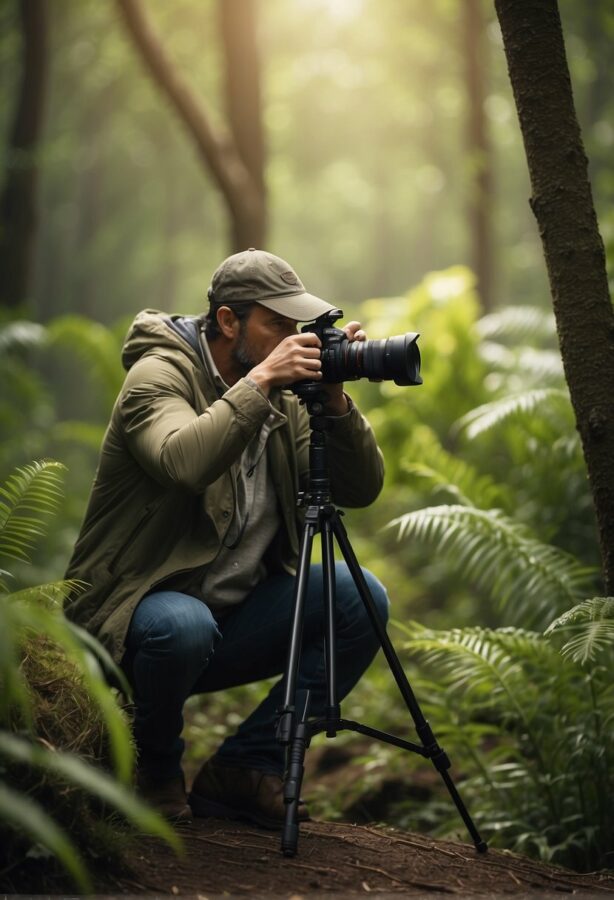
When venturing into wildlife photography, your camera choice can greatly impact your results. Different cameras bring various advantages, depending on sensor size and type, resolution, and additional features they provide.
Sensor Size: Sensor size is fundamental in image quality.
- Full Frame sensors are larger, offering detailed images and better performance in low light.
- APS-C sensors, smaller than full frame, offer a mix of quality and portability. They often have a crop factor that can give extra reach for distant wildlife.
- Micro Four Thirds offer even smaller sensors, which can further extend the effective focal length of your lenses – beneficial for capturing small or distant animals.
CAMERA TYPE:
- DSLR Cameras have optical viewfinders and a wide selection of lenses. They usually offer robust build quality and better battery life.
- Mirrorless Cameras are more compact, with electronic viewfinders (EVF) which can display real-time exposure, white balance, and additional shooting information.
Image Quality and Performance:
- Resolution details the sharpness of your photographs. Higher megapixel count often translates to greater detail, helping with post-capture cropping.
- Image Stabilization reduces camera shake, critical when shooting at longer focal lengths or in lower light conditions.
- Autofocus System is vital for capturing moving subjects. Look for systems with a high number of focus points and technologies like contrast detect or phase detect autofocus for accuracy and speed.
- Burst Shooting/Continuous Shooting Speed: The ability to capture multiple frames per second (fps) can be crucial for shooting quick action.
Additional Considerations:
- Viewfinder Quality: An EVF should be clear and lag-free.
- CMOS Sensor: Widely used for good image quality and speed.
- Memory Card Slots: Dual slots can be useful for backup or extended storage.
- Weather Sealing: Important for outdoor shooting to protect your camera from the elements.
- Build Quality: Affects the durability of your camera, especially when frequently outdoors.
Selecting the right camera for wildlife photography requires balancing these aspects to suit your shooting style and the subjects you aim to capture.
DSLR Vs Mirrorless

When choosing between DSLR (Digital Single-Lens Reflex) and mirrorless cameras for wildlife photography, there are several key factors for you to consider.
DSLRs typically have a longer battery life due to their energy-efficient optical viewfinders. For extended wildlife shoots, this can be a great advantage. You can expect solid performance from models like the Canon EOS 90D, which offers a comfortable grip and is equipped with a mechanical shutter—beneficial for fast-moving subjects.
On the other hand, mirrorless cameras are generally lighter and more compact, an essential consideration if you’re trekking to remote locations. Cameras such as the Canon EOS R5 and Nikon mirrorless systems offer advanced autofocus (AF) systems that are highly beneficial for tracking quick-moving wildlife.
Furthermore, many mirrorless systems, including the OM SYSTEM OM-1, integrate in-body image stabilization (IBIS), which aids in shooting at slower shutter speeds or while hand-holding the camera.
With mirrorless cameras, you’ll find that the electronic viewfinder (EVF) can consume more power. However, an advantage is the real-time exposure preview—an asset when shooting in varying light conditions. For additional durability, many mirrorless models feature weather-sealed bodies; ideal for outdoor, rugged conditions.
Your choice may also depend on whether the camera lenses you own are compatible with mirrorless systems through the use of adapters, as seen with many Canon mirrorless models. If not, you might need to invest in new lenses, which is a key consideration in terms of budget and usability.
Below is a quick reference guide for your consideration:
Feature | DSLR | Mirrorless |
|---|---|---|
Battery Life | Generally longer | Shorter, due to EVF |
Autofocus | Fast, but mirrorless is catching up quickly | Extremely fast with newer technology |
Weight & Size | Heavier and bulkier | Lighter and more compact |
Viewfinder | Optical (energy-efficient) | Electronic (real-time exposure preview, higher battery use) |
In-Body Image Stabilization | Less common | More common with newer models |
Adaptability with Lenses | Generally good with same brand lenses | Often requires adapters for older lenses |
Remember to ensure that your choice of camera aligns with your specific needs in wildlife photography, whether it’s the longevity of a DSLR or the advanced features of a mirrorless camera.
Best Cameras For Beginners
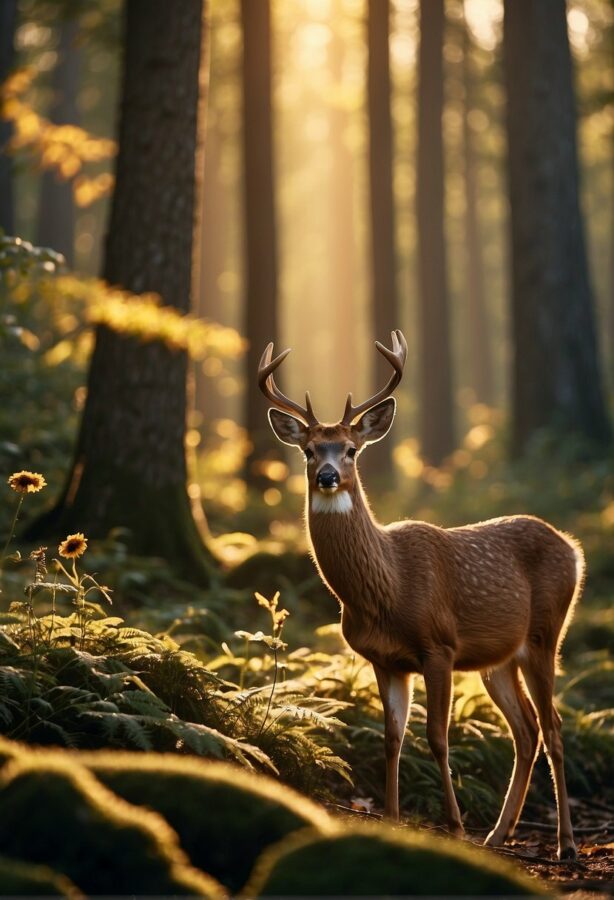
When venturing into wildlife photography, your gear can make a significant difference. You’ll need a camera that balances performance, portability, and price. Here are some top-tier choices that professionals recommend for beginners.
Top Picks For Professionals
Canon EOS 90D
- Sensor: 32.5MP APS-C CMOS sensor
- Burst Shooting: 10 frames per second
- Autofocus: 45-point all cross-type AF system
- This DSLR camera is a solid choice if you’re looking for a combination of high resolution and fast shooting speed. Its robust autofocus system helps track fast-moving wildlife.
Nikon D500
- Sensor: 20.9MP DX-Format CMOS sensor
- Burst Shooting: 10 frames per second
- Autofocus: 153-point AF system
- The Nikon D500 excels in fast action shooting situations and low light conditions, making it ideal for capturing wildlife in their natural habitats.
Canon EOS R7
- Sensor: 32.5MP APS-C CMOS sensor
- Burst Shooting: Up to 15 frames per second
- Autofocus: Dual Pixel CMOS AF II with 651 zones
- As a mirrorless solution, the EOS R7 brings advanced autofocus capabilities and high burst rates, perfect for tracking wildlife without the bulk of a DSLR.
OM System OM-1
- Sensor: 20MP Four Thirds Live MOS sensor
- Burst Shooting: Up to 10 frames per second
- Autofocus: 121-point all cross-type on-chip phase detection
- The OM System OM-1’s lightweight design and strong autofocus system offer a great option for beginners who need to move quickly and shoot in diverse conditions.
Nikon D7500
- Sensor: 20.9MP DX-Format CMOS sensor
- Burst Shooting: 8 frames per second
- Autofocus: 51-point AF system, including 15 cross-type sensors
- For wildlife photography on a budget without sacrificing quality, the Nikon D7500 is a well-rounded contender with solid imaging capabilities.
Olympus OM-D E-M10 Mark IV
- Sensor: 20MP Four Thirds CMOS sensor
- Burst Shooting: Up to 15 frames per second
- Autofocus: 121-point contrast-detection AF
- This budget-friendly mirrorless camera is compact and offers in-body image stabilization, making it simpler for you to take sharp images of wildlife.
To further aid your decision, look for reviews that address how these cameras handle in real-world shooting situations, especially when tracking subjects in the wild.
See Related: Unleashing the Wild: Exploring the World of Fierce Animals
The Importance Of Lenses
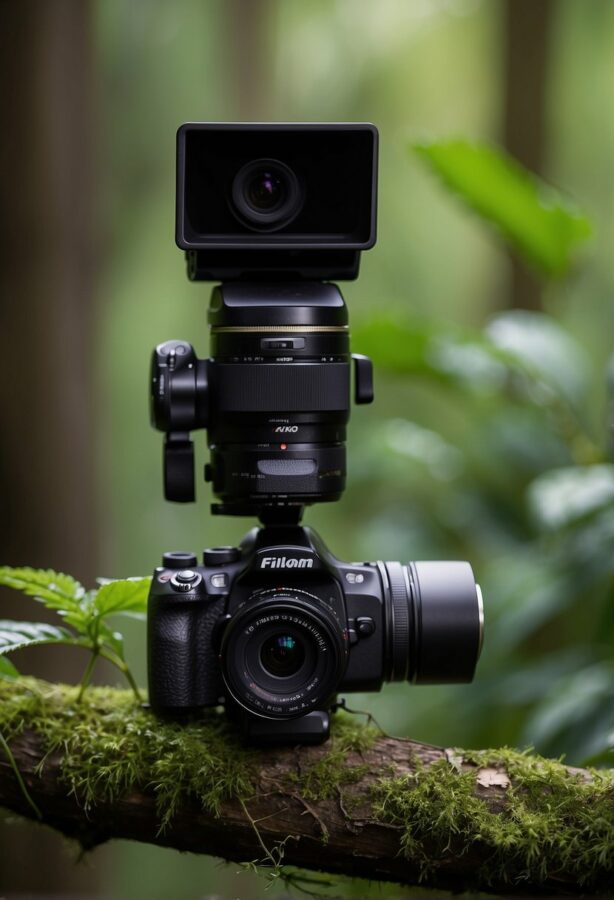
When it comes to wildlife photography, selecting the right lens is crucial for capturing sharp, detailed images of animals in their natural habitats.
Essential Accessories
Your choice of lens has a profound impact on the resulting photographs. A telephoto lens is indispensable for wildlife photography because it allows you to photograph subjects from a distance without disturbing them.
Typically, lenses with focal lengths of 300mm and 400mm are versatile and relatively lightweight, making them convenient for fieldwork. For closer and more immersive encounters, prime lenses like the 500mm f/4 or the 600mm f/4 provide exceptional quality, although they can be heavier and more expensive.
When considering a telephoto lens, pay attention to the Minimum Focus Distance (MFD), which defines how close you can be to the subject and still maintain focus. For lenses that are more difficult to handle due to their size and weight, accessories such as tripods and monopods become essential to stabilize your camera and prevent image blurring.
Vintage lenses can be a cost-effective alternative to modern lenses, often offering unique characteristics such as natural color rendering and bokeh. However, be mindful that vintage lenses may not support modern camera features like autofocus and image stabilization.
What’s not directly related to wildlife photography is irrelevant here, such as products from popular brands like l’Oréal, which are not associated with photographic equipment.
When pairing your lens with a camera, ensure compatibility and optimal performance. For advanced systems, you might need to tweak settings to get the most out of your gear, such as adjusting autofocus points for precise tracking or customizing the stabilization mode on lenses that offer this feature.
Cultivating Patience In The Field
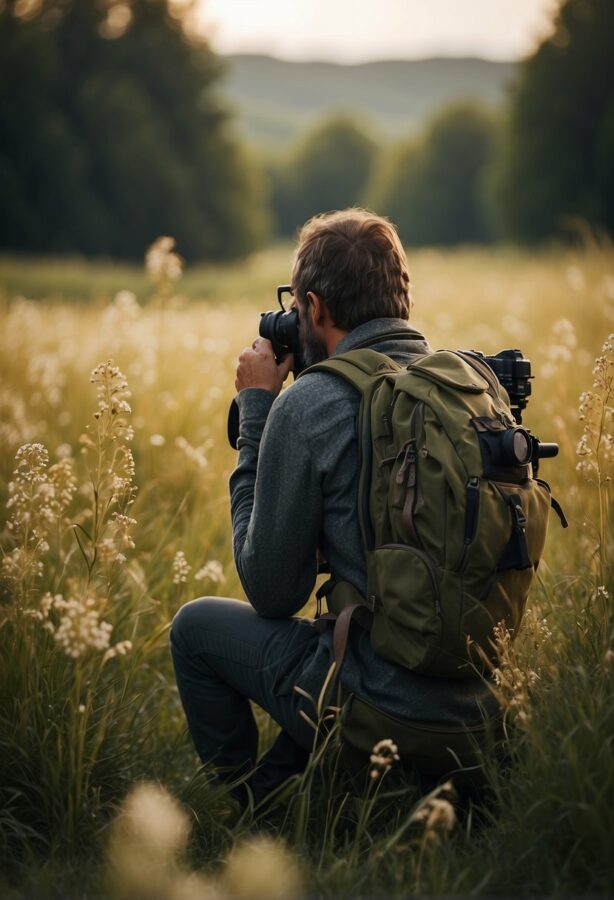
Patience is a pivotal trait for any wildlife photographer. Whether you are a professional wildlife photographer or a journalist venturing into the photographic industry, mastering this soft skill is as crucial as the technical prowess of handling your camera. This virtue goes beyond simply waiting; it’s about understanding the behavior of moving animals and making the most of each opportunity.
When selecting a camera for wildlife photography, choose one with a fast autofocus system and high frame rate to swiftly capture moving subjects without missing a beat. For instance, the Nikon D850, renowned for its stellar image quality and high speed, proves to be a standout option. Ensure your camera is set up for quiet, continuous shooting so as not to disturb wildlife.
Invest in a good telephoto lens to maintain a respectful distance from the animals. With the Canon EOS-1D X Mark II, complemented by its exceptional tracking system, you’ll find capturing clear, sharp images of even the fastest moving subjects achievable.
Compose your shots with intention, knowing that the Sony Alpha a9, with its silent shutter feature, will allow you to remain inconspicuous while documenting wildlife behavior.
Remember, tracking animals takes time and diligence. Immerse yourself in their habitat, learn their patterns, and be ready with your best wildlife photography camera when the moment arrives.
Utilize your observation skills to predict behavior and align this with the technical setup of your camera. This synergy of patience and technical readiness elevates your craft to that of the most esteemed photographers in the field.
See Related: The Silent Crisis of Feeding Wild Animals: Here’s What You Should Actually Do
Ethical Photography Practices
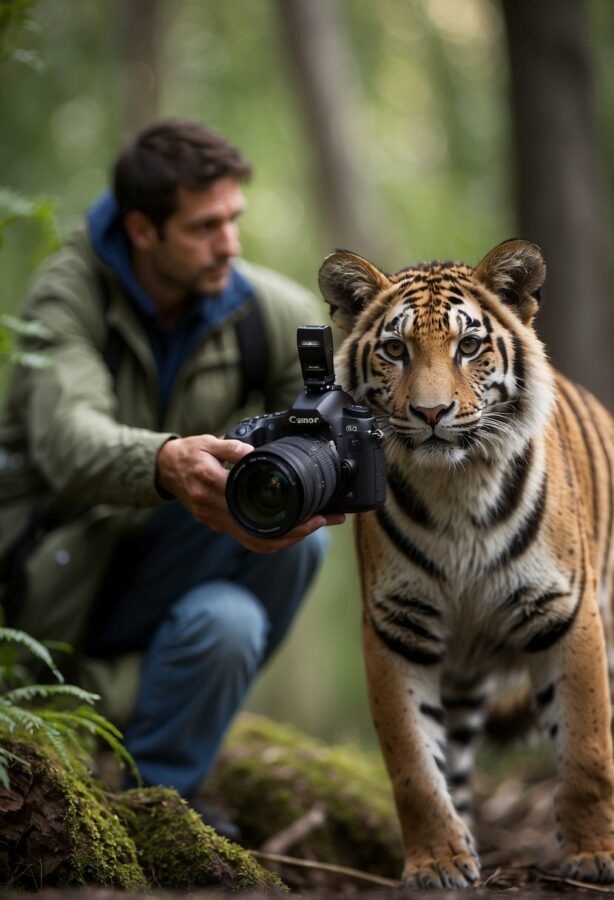
When engaging in wildlife photography, it’s essential that you uphold ethical standards to protect your subjects and their habitats. Here’s how you can be responsible with your wildlife photography camera:
Legality and Respect: Always adhere to local wildlife laws, whether shooting with a basic digital camera or setting up an advanced camera trap. Your practice should never disturb the natural behaviors or environment of the wildlife you’re photographing.
Feeding and Baiting: As a professional wildlife photographer, never feed or bait animals just to capture a perfect shot. It disrupts their natural foraging habits and can be harmful.
Use of Technology:
- Autofocus Points: Maximize your camera’s autofocus points to quickly capture sharp images, reducing the time spent in the animal’s vicinity.
- Camera Trap: Employ camera traps wisely, placing them in areas that minimize habitat disturbance, and using them as tools for natural observation rather than manipulation.
Equipment:
- Elinchrom: For those using Elinchrom lighting gear, be mindful that artificial light can stress wildlife. Use ambient light when possible, and restrict flash usage to daylight hours to avoid disorienting nocturnal species.
- Wildlife Cameras: Select cameras with silent shutter or quiet modes to prevent scaring off your subjects.
Education and Sharing:
- Digital Camera World: Enhance your skills by continuously learning from reputable sources such as the ‘Digital Camera World’ newsletter.
- Aston Martin Racing: Just as Aston Martin Racing embodies precision and excellence, aim to carry these qualities into your wildlife photography by being patient and waiting for the right moment rather than disrupting the scene.
Remember that your actions have a profound impact. Ethically using your wildlife photography cameras ensures that you respect the wildlife and its habitat, producing not only stunning photographs but also contributing to the preservation of nature.
Related Resources: